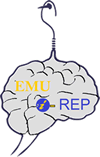ÖZ:
Bu çalışmada, 18-36 aylık çocuğa olan ebeveyinlerin Değiştirilmiş Erken
Çocukluk Dönemi Otizm Tarama Ölçeği (M-CHAT) ile otizm belirtilerini tanıma
durumları ve otizm yönünde risk altında olan çocukların belirlenmesi amaçlanmıştır.
Çalışmanın evrenini KKTC İskele Sağlık Merkezine 2021 yılı Mayıs-Ağustos
aylarında, genel sağlık kontrolüne veya aşı yaptırma gibi nedenlerle gelen ebeveynler
(N=342) oluşturmuştur. Örneklem seçimine gidilmemiş, araştırmaya giriş kriterlerine
uyan ve araştırmaya katılmayı gönüllü olarak kabul eden ebeveynler (n=300)
oluşturmuştur. Veriler; “Ebeveyn Sosyodemografik Bilgi Formu’’ ve “M - Chat
Tarama Ölçeği’’ ile kullanılmıştır. Veriler; sayı, yüzde, ortalama ile gösterilmiştir.
Veriler, %95 güven aralığında, % 5 hata payı ile kabul edilmiştir.
Araştırmaya katılan ebeveylerin yaş ortalamasının 32.2±3.3 olduğu, M-CHAT
ölçeğine göre çocuklarında otizm riski olan ebeveynlerin (n=5; %1.7) yaş aralığınının
27-35’de olduğu, bu çocukların 1’inin normal doğum ile, 4’ünün ise sezeryan doğum
ile dünyaya geldiği belirlenmiştir. Ebeveynlerin %44,67’sinin lisans mezunu olduğu
saptanmıştır. Risk grubuna giren çocukların %28,3’ünün tek çocuklu ailede,
%33,6’sinin 2 çocuklu ailede, %23,0’ünün ise 3 çocuklu ailede yaşadığı belirlenmiştir.
Çocukların tamamının evde aileleriyle yaşadığı, %90,4’nının ayrı odasının olduğu,
%98,4’ü çiğneme becerisinin olduğu, %70,6’sının yalancı emzik veya biberon
kullandığı belirlenmiştir.
Sağlık merkezinde görev yapan hemşire ve diğer sağlık çalışanlarının, erken
çocukluk döneminde çocuğu olan ailelerin çocuklarının otizm spektrum bozukluğu
açısından tarama programlarına katılmalarını teşvik etmeleri ve riski grubunda çocuğu
olan aileri ileri tetkik ve tedavi için uygun sağlık kuruluşlarına yönlendirmeleri
önerilmiştir.
In this study, it was aimed to determine the status of parents of 18-36 months
old children to recognize the signs of autism in the M-CHAT screening test and to
determine the children at risk for autism. The population of the study consisted of
parents (N=342) who came to the KKTC Iskele Health Center in May-August 2021
for reasons such as general health check or vaccination.Sample selection was not
made, and n=300 parents who met the entry criteria and voluntarily agreed to
participate in the study were formed. Data; It was collected using the "Parent
Sociodemographic Information Form" and "M-Chat Screening Scale".In the
evaluation of the data; number, percentage, mean, standard deviation were used for
descriptive statistics, and CI-square test was used to compare categorical variables.
The data were accepted with a 95% confidence interval and an error of 5%.The mean
age of the parents participating in the study was 32.2±3.3, the age range of the parents
whose children were at risk of autism according to the M-CHAT scale (n=5; 1.7%)
was 27-35, 1 of these children was born with normal birth and 4 of them were born
with normal birth. It was determined that he was born by cesarean section.It was
determined that 44.67% of the parents were undergraduate graduates. It was
determined that 28.3% of the children in the risk group live in a family with one child,
33.6% live in a family with two children, and 23.0% live in a family with three
children. It was determined that all of the children lived at home with their families,
90.4% had a separate room, 98.4% had chewing skills, and 70.6% used pacifiers or
feeding bottles.It has been recommended that nurses and other health professionals
working in the health center encourage the participation of autism spectrum disorder
children in screening programs in terms of autism spectrum disorder and refer families
with children in the risk group to appropriate health institutions for further examination
and treatment.









